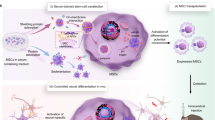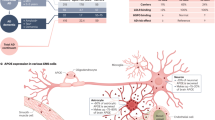Abstract
Background
Perineural invasion (PNI) is a prevalent phenomenon in salivary adenoid cystic carcinoma (SACC). Nevertheless, the regulatory mechanism of PNI is largely elusive.
Methods
We detected Apolipoprotein D (ApoD) expression and further determined its role in SACC progression. Subsequently, the contributions of SACC-derived ApoD on neurite outgrowth of dorsal root ganglions (DRGs) cells were explored. Moreover, a series of in vivo assays were conducted to elucidate the role of ApoD in the SACC PNI process.
Results
We observed a dramatic up-regulation of ApoD in the SACC associated with an enhancement of PNI in patient biopsies. We found that SACC-derived ApoD elevated cancer cell migration and invasion. In addition, ApoD could facilitate the neurite outgrowth of cultured DRG cells in a CXCR4-dependent manner in vitro, as well as innervation, angiogenesis, and invasion along peripheral nerves of SACC in vivo. More importantly, by advanced bioinformatic analysis, we unexpectedly revealed a novel phenomenon ‘tumour cell to neuron-like cell transition’ in the ApoD-rich microenvironment in vivo, contributing to the neurogenesis in the SACC tumour.
Conclusion
we discovered a novel role of cancer-derived ApoD in the pathogenesis of PNI, which may represent an effective therapeutic target for SACC in clinics.
This is a preview of subscription content, access via your institution
Access options
Subscribe to this journal
Receive 24 print issues and online access
269,00 € per year
only 11,21 € per issue
Buy this article
- Purchase on SpringerLink
- Instant access to full article PDF
Prices may be subject to local taxes which are calculated during checkout





Similar content being viewed by others
Data availability
The RNA-seq data have been submitted to the GEO database with the accession number is GSE281812.
References
Nightingale J, Lum B, Ladwa R, Simpson F, Panizza B. Adenoid cystic carcinoma: a review of clinical features, treatment targets and advances in improving the immune response to monoclonal antibody therapy. Biochim Biophys Acta Rev Cancer. 2021;1875:188523.
Cordesmeyer R, Schliephake H, Kauffmann P, Tröltzsch M, Laskawi R, Ströbel P, et al. Clinical prognostic factors of salivary adenoid cystic carcinoma: a single-center analysis of 61 patients. J Craniomaxillofac Surg. 2017;45:1784–7.
Melgarejo da Rosa M, Clara Sampaio M, Virgínia Cavalcanti Santos R, Sharjeel M, Araújo C, Galdino da Rocha Pitta M, et al. Unveiling the pathogenesis of perineural invasion from the perspective of neuroactive molecules. Biochem Pharm. 2021;188:114547.
Liu X, Yang X, Zhan C, Zhang Y, Hou J, Yin X. Perineural invasion in adenoid cystic carcinoma of the salivary glands: where we are and where we need to go. Front Oncol. 2020;10:1493.
Zhang M, Wu JS, Xian HC, Chen BJ, Wang HF, Yu XH, et al. CXCR5 induces perineural invasion of salivary adenoid cystic carcinoma by inhibiting microRNA-187. Aging. 2021;13:15384–99.
Wang J, Yang Z, Liu Y, Li H, Yang X, Gao W, et al. The GAL/GALR2 axis promotes the perineural invasion of salivary adenoid cystic carcinoma via epithelial-to-mesenchymal transition. Cancer Med. 2022. https://doi.org/10.1002/cam4.5181.
Saleh E, Ukwas A. Adenoid cystic carcinoma of salivary glands: a ten-year review and an assessment of the current management, surgery, radiotherapy, and chemotherapy. Int J Otolaryngol. 2023;2023:7401458.
Liebig C, Ayala G, Wilks JA, Berger DH, Albo D. Perineural invasion in cancer: a review of the literature. Cancer. 2009;115:3379–91.
Demir IE, Friess H, Ceyhan GO. Neural plasticity in pancreatitis and pancreatic cancer. Nat Rev Gastroenterol Hepatol. 2015;12:649–59.
Cervantes-Villagrana RD, Albores-García D, Cervantes-Villagrana AR, García-Acevez SJ. Tumor-induced neurogenesis and immune evasion as targets of innovative anti-cancer therapies. Signal Transduct Target Ther. 2020;5:99.
Chatterjee D, Katz MH, Rashid A, Wang H, Iuga AC, Varadhachary GR, et al. Perineural and intraneural invasion in posttherapy pancreaticoduodenectomy specimens predicts poor prognosis in patients with pancreatic ductal adenocarcinoma. Am J Surg Pathol. 2012;36:409–17.
Jaber MA, Hassan M, Ingafou M, Elameen AM. Adenoid cystic carcinoma of the minor salivary glands: a systematic review and meta-analysis of clinical characteristics and management strategies. J Clin Med. 2024;13:267.
Rassart E, Desmarais F, Najyb O, Bergeron KF, Mounier C. Apolipoprotein D. Gene. 2020;756:144874.
Ma P, Zhang G, Chen S, Miao C, Cao Y, Wang M, et al. Promotion effect of TGF-β-Zfp423-ApoD pathway on lip sensory recovery after nerve sacrifice caused by nerve collateral compensation. Int J Oral Sci. 2023;15:23.
Pascual G, Domínguez D, Elosúa-Bayes M, Beckedorff F, Laudanna C, Bigas C, et al. Dietary palmitic acid promotes a prometastatic memory via Schwann cells. Nature. 2021;599:485–90.
Zhang JF, Tao LY, Yang MW, Xu DP, Jiang SH, Fu XL, et al. CD74 promotes perineural invasion of cancer cells and mediates neuroplasticity via the AKT/EGR-1/GDNF axis in pancreatic ductal adenocarcinoma. Cancer Lett. 2021;508:47–58.
Huang GZ, Wu QQ, Zheng ZN, Shao TR, Chen YC, Zeng WS, et al. M6A-related bioinformatics analysis reveals that HNRNPC facilitates progression of OSCC via EMT. Aging. 2020;12:11667–84.
Huyett P, Gilbert M, Liu L, Ferris RL, Kim S. A model for perineural invasion in head and neck squamous cell carcinoma. J Vis Exp. 2017. https://doi.org/10.3791/55043.
Jeong WJ, Choi IJ, Park MW, An SY, Jeon EH, Paik JH, et al. CXCR4 antagonist inhibits perineural invasion of adenoid cystic carcinoma. J Clin Pathol. 2014;67:992–8.
Li X, Wang Z, Ma Q, Xu Q, Liu H, Duan W, et al. Sonic hedgehog paracrine signaling activates stromal cells to promote perineural invasion in pancreatic cancer. Clin Cancer Res. 2014;20:4326–38.
Jurcak NR, Rucki AA, Muth S, Thompson E, Sharma R, Ding D, et al. Axon guidance molecules promote perineural invasion and metastasis of orthotopic pancreatic tumors in mice. Gastroenterology. 2019;157:838–50.e836.
Hung YH, Hou YC, Hsu SH, Wang LY, Tsai YL, Shan YS, et al. Pancreatic cancer cell-derived semaphorin 3A promotes neuron recruitment to accelerate tumor growth and dissemination. Am J Cancer Res. 2023;13:3417–32.
Sanchez D, Ganfornina MD. The lipocalin Apolipoprotein D functional portrait: a systematic review. Front Physiol. 2021;12:738991.
Tang PC, Chung JY, Liao J, Chan MK, Chan AS, Cheng G, et al. Single-cell RNA sequencing uncovers a neuron-like macrophage subset associated with cancer pain. Sci Adv. 2022;8:eabn5535.
Wang Q, Vattai A, Vilsmaier T, Kaltofen T, Steger A, Mayr D, et al. Immunogenomic identification for predicting the prognosis of cervical cancer patients. Int J Mol Sci. 2021;22:2442.
Selvaggi F, Melchiorre E, Casari I, Cinalli S, Cinalli M, Aceto GM, et al. Perineural invasion in pancreatic ductal adenocarcinoma: from molecules towards drugs of clinical relevance. Cancers. 2022;14:5793.
Yin L, Li J, Wang J, Pu T, Wei J, Li Q, et al. MAOA promotes prostate cancer cell perineural invasion through SEMA3C/PlexinA2/NRP1-cMET signaling. Oncogene. 2021;40:1362–74.
Su R, Zhong S, Wang P, Lin Z. Induction of perineural invasion in salivary adenoid cystic carcinoma by circular RNA RNF111. Clin Transl Oncol. 2023;25:3152–64. https://doi.org/10.1007/s12094-023-03182-w.
Bakst RL, Wong RJ. Mechanisms of perineural invasion. J Neurol Surg B Skull Base. 2016;77:96–106.
Magnon C, Hall SJ, Lin J, Xue X, Gerber L, Freedland SJ, et al. Autonomic nerve development contributes to prostate cancer progression. Science. 2013;341:1236361.
Desmarais F, Bergeron KF, Rassart E, Mounier C. Apolipoprotein D overexpression alters hepatic prostaglandin and omega fatty acid metabolism during the development of a non-inflammatory hepatic steatosis. Biochim Biophys Acta Mol Cell Biol Lipids. 2019;1864:522–31.
Al-Raimi HAI, Kong J, Ran Y, Zhu L, Li J, Liu X, et al. Extracellular vesicles from carcinoma-associated fibroblasts promote EMT of salivary adenoid cystic carcinoma via IL-6. Arch Med Res. 2023;54:27–36.
Mengie Ayele T, Tilahun Muche Z, Behaile Teklemariam A, Bogale Kassie A, Chekol Abebe E. Role of JAK2/STAT3 signaling pathway in the tumorigenesis, chemotherapy resistance, and treatment of solid tumors: a systemic review. J Inflamm Res. 2022;15:1349–64.
Lin D, Zhang H, Zhang J, Huang K, Chen Y, Jing X, et al. α-Synuclein induces neuroinflammation injury through the IL6ST-AS/STAT3/HIF-1α axis. Int J Mol Sci. 2023;24:1436.
Bu LL, Deng WW, Huang CF, Liu B, Zhang WF, Sun ZJ. Inhibition of STAT3 reduces proliferation and invasion in salivary gland adenoid cystic carcinoma. Am J Cancer Res. 2015;5:1751–61.
Guo K, Ma Q, Li J, Wang Z, Shan T, Li W, et al. Interaction of the sympathetic nerve with pancreatic cancer cells promotes perineural invasion through the activation of STAT3 signaling. Mol Cancer Ther. 2013;12:264–73.
Zhang M, Zheng M, Dai L, Zhang WL, Fan HY, Yu XH, et al. CXCL12/CXCR4 facilitates perineural invasion via induction of the Twist/S100A4 axis in salivary adenoid cystic carcinoma. J Cell Mol Med. 2021;25:7901–12.
Klein Nulent TJW, van Es RJJ, Valstar MH, Smeele LE, Smit LA, Klein Gunnewiek R, et al. High CXCR4 expression in adenoid cystic carcinoma of the head and neck is associated with increased risk of locoregional recurrence. J Clin Pathol. 2020;73:476–82.
Amit M, Na’ara S, Gil Z. Mechanisms of cancer dissemination along nerves. Nat Rev Cancer. 2016;16:399–408.
Silverman DA, Martinez VK, Dougherty PM, Myers JN, Calin GA, Amit M. Cancer-associated neurogenesis and nerve-cancer cross-talk. Cancer Res. 2021;81:1431–40.
Usman S, Waseem NH, Nguyen TKN, Mohsin S, Jamal A, Teh MT, et al. Vimentin is at the heart of epithelial mesenchymal transition (EMT) mediated metastasis. Cancers. 2021;13:4985.
Parvanian S, Coelho-Rato LS, Patteson AE, Eriksson JE. Vimentin takes a hike—emerging roles of extracellular vimentin in cancer and wound healing. Curr Opin Cell Biol. 2023;85:102246.
Maybee DV, Ink NL, Ali MAM. Novel roles of MT1-MMP and MMP-2: beyond the extracellular milieu. Int J Mol Sci. 2022;23:9513.
Yang X, Zhang P, Ma Q, Kong L, Li Y, Liu B, et al. EMMPRIN silencing inhibits proliferation and perineural invasion of human salivary adenoid cystic carcinoma cells in vitro and in vivo. Cancer Biol Ther. 2012;13:85–91.
Yang X, Jing D, Liu L, Shen Z, Ju J, Ma C, et al. Downregulation of p53 promotes in vitro perineural invasive activity of human salivary adenoid cystic carcinoma cells through epithelial-mesenchymal transition-like changes. Oncol Rep. 2015;33:1650–6.
Ganfornina MD, Do Carmo S, Martínez E, Tolivia J, Navarro A, Rassart E, et al. ApoD, a glia-derived apolipoprotein, is required for peripheral nerve functional integrity and a timely response to injury. Glia. 2010;58:1320–34.
Acknowledgements
We sincerely acknowledge Xiaoting Chen and Xijing Yang from the Animal Experimental Center of West China Hospital for technical assistance in animal experiments. In addition, we acknowledge Juan Wu for the data processing and contribution on RNA-Seq submitting.
Funding
This study was funded by the National Natural Science Foundation of China (82270994), the Science and Technology Department of Sichuan Province (2023NSFSC0704, 2023NSFSC0573).
Author information
Authors and Affiliations
Contributions
Huang GZ: methodology, investigation, data curation, visualisation, writing—original draft and writing—review & editing; Chen S: investigation, data curation, formal analysis and visualisation; Han B: investigation, funding acquisition; Zhang GW: investigation; Bao MZ: data curation; Paka Lubamba G: formal analysis; Hua YF: data curation; Li HL: investigation; Liu WW: writing—review & editing; Shen JF: writing—review & editing; Wang L: writing—review & editing; Lin J: supervision, funding acquisition; Patrick Ming-Kuen Tang: supervision and writing—review & editing; Ding ZF: methodology, supervision and writing—review & editing; Li CJ: conceptualisation, methodology, project administration, supervision, funding acquisition and writing—review & editing.
Corresponding authors
Ethics declarations
Competing interests
The authors declare no competing interests.
Ethical approval
Written informed consent was obtained from all patients. This study was approved by the Ethical Committee of West China School of Stomatology, Sichuan University (WCHSIRB-D-2022-445). All animal experiments were approved by the Animal Ethical Committee of West China School of Stomatology, Sichuan University (WCHSIRB-D-2022-337). All methods were performed in accordance with the relevant guidelines and regulations.
Consent for publication
All authors reviewed and agreed to publication.
Additional information
Publisher’s note Springer Nature remains neutral with regard to jurisdictional claims in published maps and institutional affiliations.
Supplementary information
Rights and permissions
Springer Nature or its licensor (e.g. a society or other partner) holds exclusive rights to this article under a publishing agreement with the author(s) or other rightsholder(s); author self-archiving of the accepted manuscript version of this article is solely governed by the terms of such publishing agreement and applicable law.
About this article
Cite this article
Huang, G., Chen, S., Han, B. et al. Apolipoprotein D is crucial for promoting perineural invasion in salivary adenoid cystic carcinoma. Br J Cancer 132, 599–610 (2025). https://doi.org/10.1038/s41416-025-02946-1
Received:
Revised:
Accepted:
Published:
Issue Date:
DOI: https://doi.org/10.1038/s41416-025-02946-1



